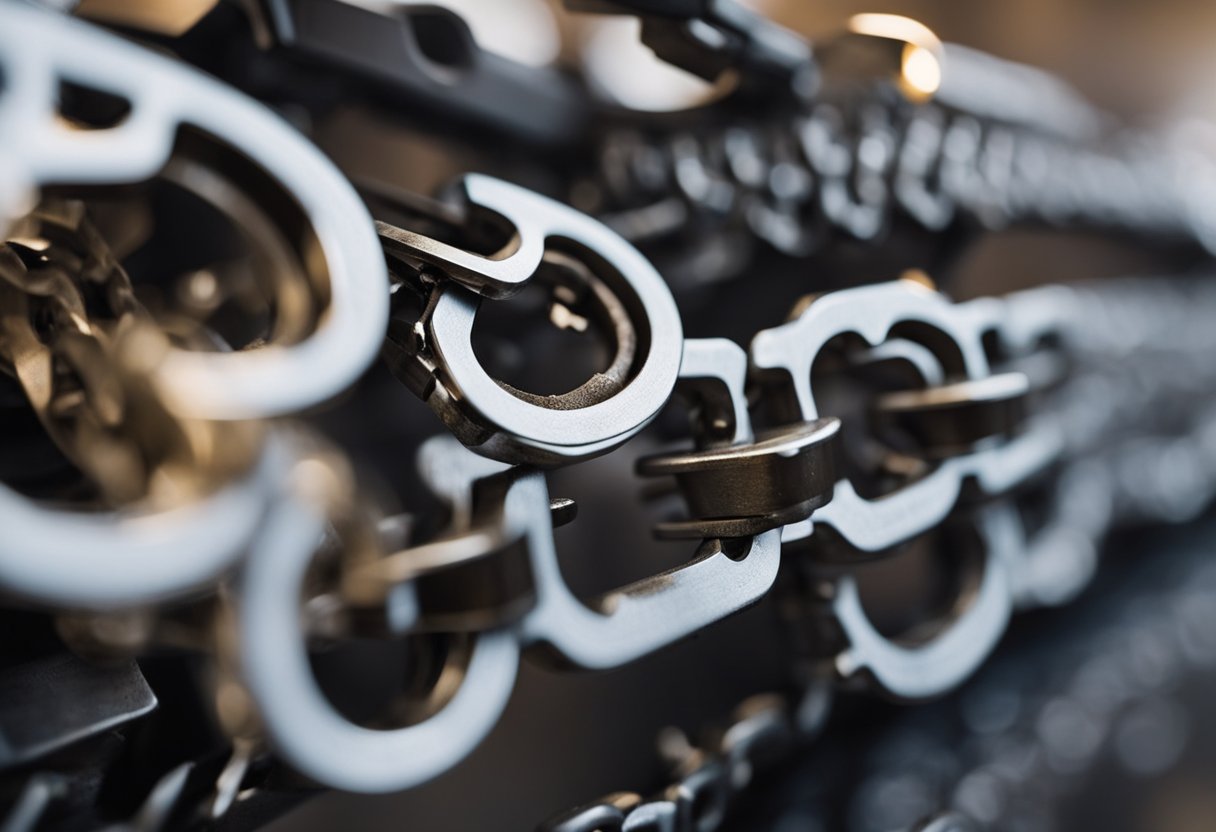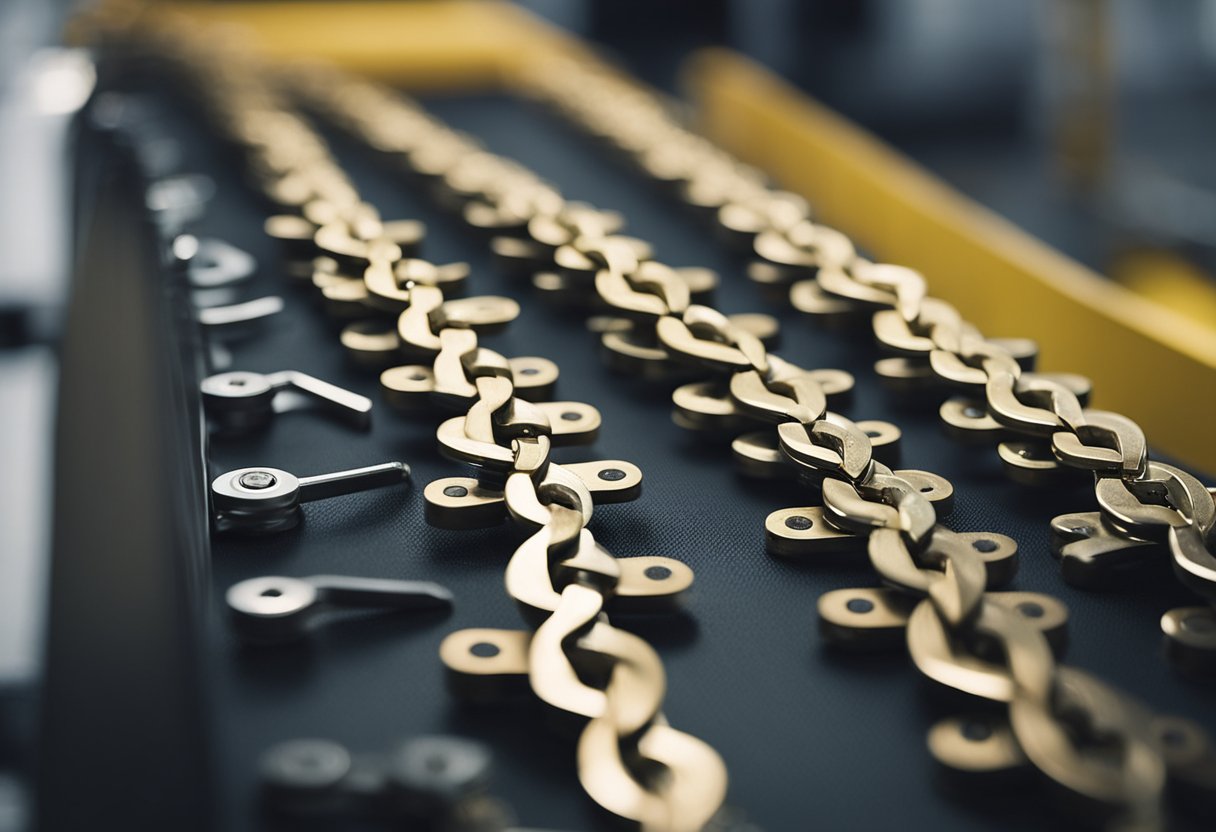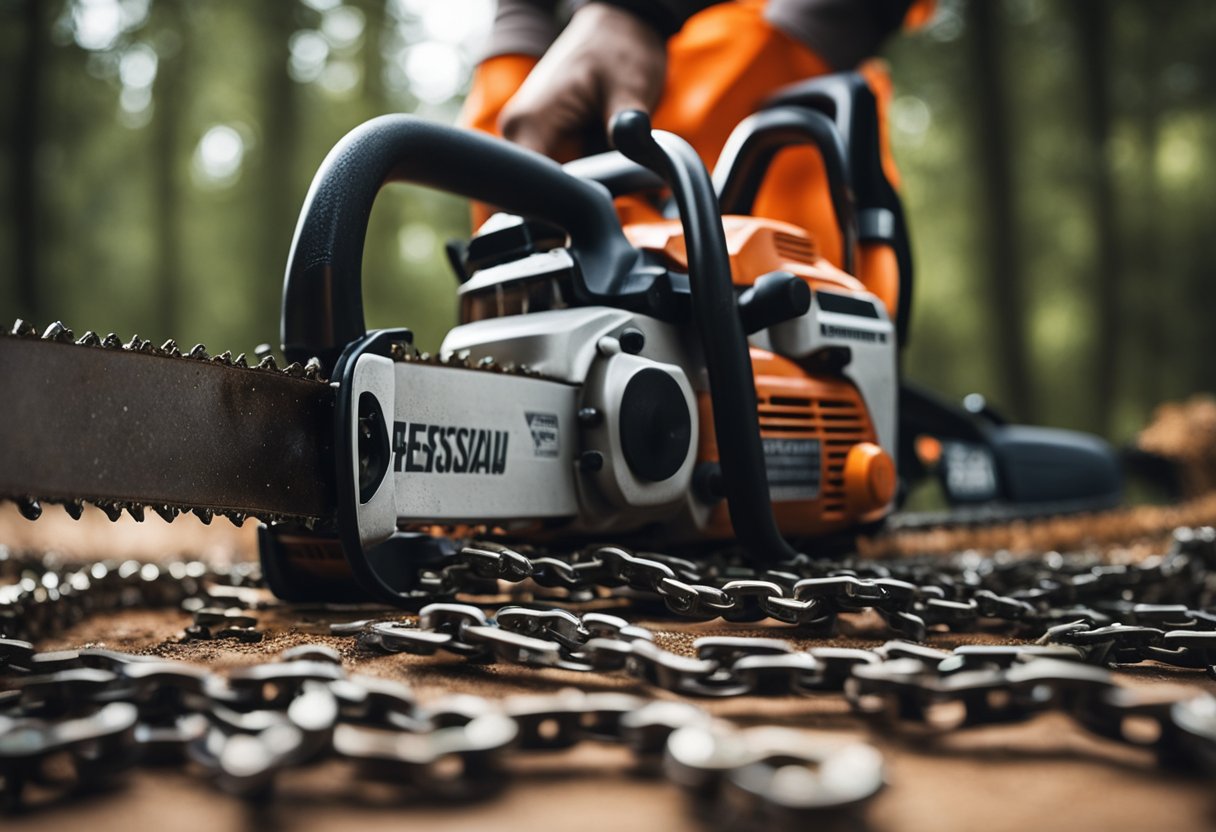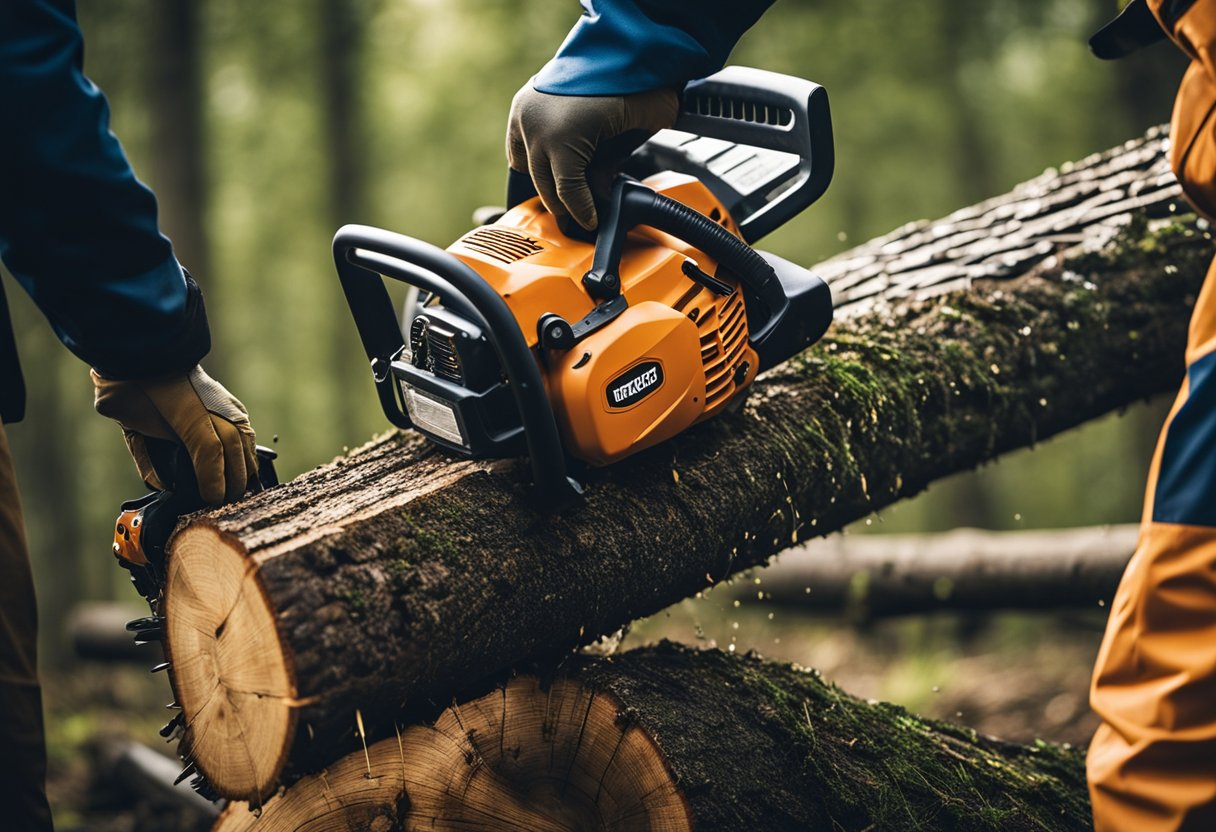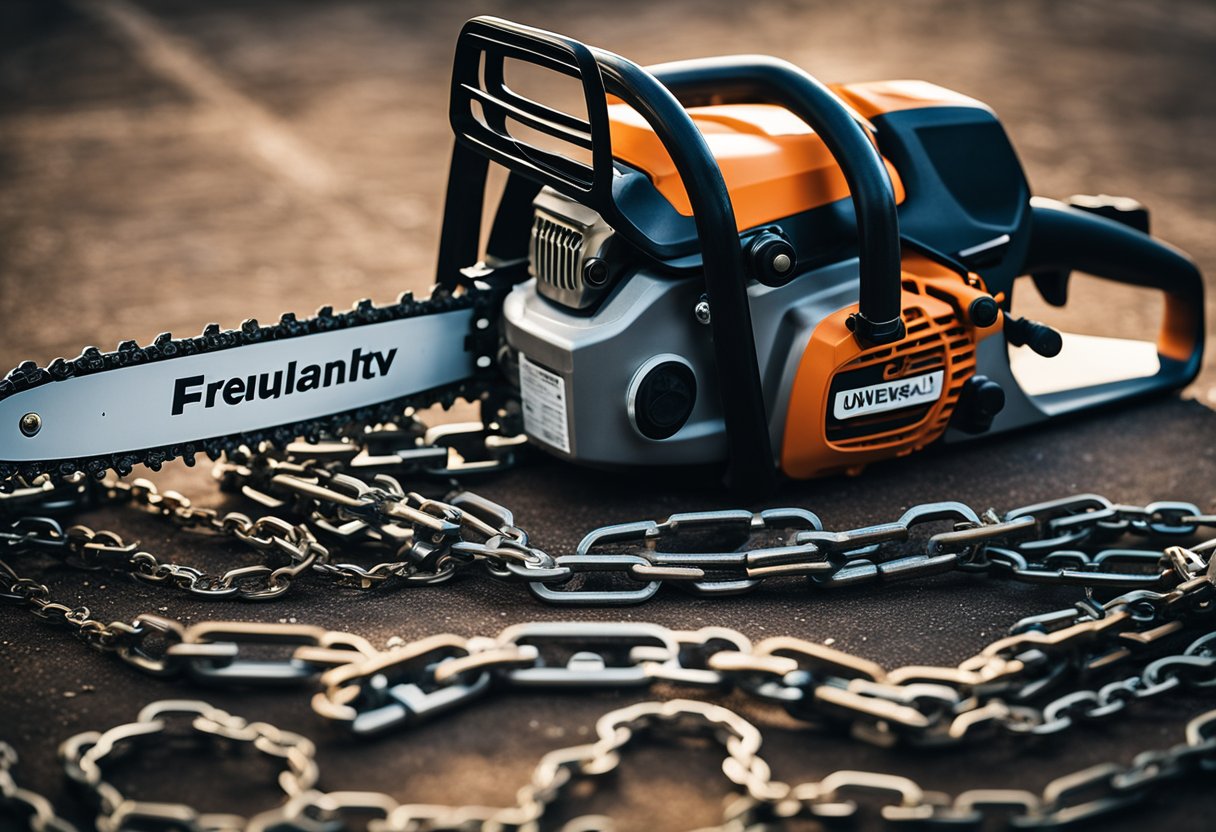Are chainsaw chains universal? This is a common question that many people ask when they are in need of a replacement chain for their chainsaw. The short answer is no, chainsaw chains are not universal. However, there are some exceptions to this rule.
Understanding chainsaw chains is essential to finding the right replacement chain for your chainsaw. Chainsaw chains consist of a series of links that are connected together to form a loop. The pitch, gauge, and number of links in the chain determine its compatibility with your chainsaw. It is important to know the exact specifications of your chainsaw chain to avoid any compatibility issues. In the following sections, we will explore the factors that determine chainsaw chain compatibility and how to identify the specifications of your chainsaw chain.
Key Takeaways
- Chainsaw chains are not universal and must match the specifications of your chainsaw for proper compatibility.
- Identifying the pitch, gauge, and number of links in your chainsaw chain is essential to finding the right replacement chain.
- Regular maintenance and care of your chainsaw chain is crucial for optimal performance and longevity.
Understanding Chainsaw Chains
https://www.youtube.com/watch?v=iY-qgN6StuQ&embed=true
As a chainsaw user, it’s essential to understand the different types of chainsaw chains available in the market. Chainsaw chains come in different types, sizes, and configurations, and it’s important to choose the right one for your chainsaw to ensure optimal performance.
Types of Chainsaw Chains
The three most common types of chainsaw chains are semi-chisel chains, full-chisel chains, and low-profile chains. Semi-chisel chains are ideal for cutting softwood, while full-chisel chains are best suited for hardwoods and other hard materials. Low-profile chains, on the other hand, are designed for use on smaller chainsaws and are ideal for light-duty tasks.
Chain Sequence
The chain sequence refers to the direction in which the chain teeth cut. Chainsaw chains can either have a standard or reverse sequence. The standard sequence is the most common and is used for most cutting tasks, while the reverse sequence is used for special applications such as plunge cutting.
Chain Pitch and Gauge
Chain pitch and gauge are two essential measurements that you need to consider when choosing a chainsaw chain. The pitch refers to the distance between two chain links and is measured in inches. The gauge, on the other hand, refers to the thickness of the drive links and is also measured in inches. It’s important to choose a chain with the correct pitch and gauge to ensure proper fitting and optimal performance.
Number of Drive Links
The number of drive links on a chainsaw chain is also an important consideration. The drive links are the part of the chain that fits into the chainsaw’s guide bar. The number of drive links determines the length of the chain, and it’s important to choose a chain with the correct number of drive links to ensure proper fitting.
Measuring Chainsaw Chains
To measure a chainsaw chain, you need to determine the pitch, gauge, and number of drive links. You can use a pitch gauge and depth gauge to determine the pitch and gauge, respectively. The number of drive links can be determined by counting the number of rivets on the chain.
In conclusion, understanding chainsaw chains is crucial for achieving optimal performance. By considering factors such as chain type, chain sequence, pitch, gauge, and number of drive links, you can choose the right chainsaw chain for your needs.
Are Chainsaw Chains Universal?
https://www.youtube.com/watch?v=abZEGsTYVPA&embed=true
As a chainsaw owner, you may wonder if chainsaw chains are universal or interchangeable across brands. The simple answer is no. Chainsaw chains are not universal because their gauge and pitch are determined by the specific chainsaw you use. Each chainsaw model has its own unique requirements for chain size, making it crucial to find the right fit for optimal performance and safety.
To determine the right chain size for your chainsaw, you need to know three primary requirements of your guide bar: pitch, gauge, and drive link count. The pitch is the distance between the links, gauge is the thickness of the drive links, and drive link count is the number of drive links that fit into the guide bar.
It is important to note that even chainsaw chains from the same manufacturer may not be interchangeable between different models. For example, a chainsaw chain designed for a 16-inch bar may not fit on a 20-inch bar, even if they are from the same brand.
While chainsaw chains are not universal, mixing brands is acceptable as long as they are compatible. However, it is always recommended to use the same brand of chain as your chainsaw for optimal performance and safety.
In conclusion, chainsaw chains are not universal, and it is crucial to find the right chain size for your specific chainsaw. Knowing the pitch, gauge, and drive link count of your guide bar is essential in selecting the right chainsaw chain. Mixing brands is acceptable, but it is always recommended to use the same brand of chain as your chainsaw.
Identifying Chainsaw Chain Specifications
https://www.youtube.com/watch?v=aKfkWm5vZUg&embed=true
As a chainsaw user, it is crucial to understand the specifications of your chainsaw chain to ensure optimal performance and safety. Here are some of the essential specifications you need to know:
Bar Length
The bar length refers to the distance between the chainsaw’s front and rear tips. It is crucial to choose a chain that matches your chainsaw’s bar length. Using a chain that is too long or too short can cause damage to the chainsaw and pose safety risks.
Pitch and Gauge
The pitch and gauge are two critical measurements that determine the compatibility of a chainsaw chain with a chainsaw. The pitch is the distance between the chain’s drive lugs, while the gauge is the thickness of the drive links. It is essential to choose a chain with the correct pitch and gauge for your chainsaw to ensure optimal performance.
Bar Groove
The bar groove is the channel in the chainsaw’s guide bar that guides the chain. It is crucial to choose a chain that matches the bar groove of your chainsaw. Using a chain that is too wide or too narrow for your chainsaw’s bar groove can cause damage to the chainsaw and pose safety risks.
Sprocket
The sprocket is the toothed wheel that drives the chainsaw chain. It is essential to choose a chain that matches the sprocket of your chainsaw. Using a chain that is not compatible with your chainsaw’s sprocket can cause damage to the chainsaw and pose safety risks.
Markings and Engravings
Most chainsaw chains have markings and engravings that indicate their specifications. It is crucial to check these markings and engravings to ensure that you are using the correct chain for your chainsaw. If you are unsure about the specifications of your chainsaw chain, consult the user manual or contact the manufacturer for assistance.
In summary, understanding the specifications of your chainsaw chain is crucial for optimal performance and safety. Make sure to choose a chain that matches your chainsaw’s bar length, pitch, gauge, bar groove, and sprocket. Check the markings and engravings on the chain to ensure that you are using the correct chain for your chainsaw.
Major Chainsaw Chain Brands
https://www.youtube.com/watch?v=7_tsY2abJes&embed=true
When it comes to chainsaw chains, there are numerous brands to choose from. Each brand has its own unique features and specifications, making it important to choose the right chain for your chainsaw.
Some of the major chainsaw chain brands include Stihl, Husqvarna, and Oregon. These brands are known for producing high-quality chainsaw chains that are durable and reliable.
Stihl is a well-known brand that produces a wide range of chainsaw chains. They are known for their brand-specific chains that are designed to fit Stihl chainsaws perfectly. Stihl chains are made from high-quality materials and are designed to last for a long time.
Husqvarna is another popular brand that produces chainsaw chains. They offer a wide range of chains that are designed to fit different chainsaw models. Husqvarna chains are known for their durability and strength, making them ideal for heavy-duty applications.
Oregon is another major chainsaw chain brand that is known for producing high-quality chains. They offer a wide range of chains that are designed to fit different chainsaw models. Oregon chains are known for their sharpness and durability, making them ideal for cutting through tough materials.
When choosing a chainsaw chain brand, it is important to consider factors such as durability, strength, and compatibility with your chainsaw model. By choosing a high-quality chainsaw chain brand, you can ensure that your chainsaw will perform at its best and last for a long time.
Replacing And Adjusting Chainsaw Chains
https://www.youtube.com/watch?v=FxgQSPQeYYM&embed=true
When it comes to chainsaw chains, there may come a time when you need to replace or adjust them. It’s important to do this properly to ensure safety and optimal performance. Here are some tips to help you replace and adjust your chainsaw chains:
Replacing Chainsaw Chains
When replacing your chainsaw chain, the first step is to make sure you have the correct replacement chain. Chainsaw chains are not universal, so it’s important to get one that is compatible with your chainsaw model. You can find this information in your chainsaw manual or by looking at the existing chain on your saw.
Once you have the correct replacement chain, you can begin the process of replacing it. Here are the steps to follow:
- Turn off your chainsaw and unplug it if it’s electric.
- Remove the side plate covering the chainsaw chain.
- Loosen the tensioning screw to release the old chain.
- Remove the old chain and inspect the guide bar for damage or wear.
- Install the new chain, making sure it’s facing the right direction.
- Adjust the tension of the new chain by tightening the tensioning screw.
- Check the tension of the chain by pulling on it. It should be snug against the guide bar but still be able to move freely.
Adjusting Chainsaw Chains
If your chainsaw chain is loose or tight, it can affect the performance of your saw and even be dangerous. It’s important to adjust the chain tension properly. Here’s how to do it:
- Turn off your chainsaw and unplug it if it’s electric.
- Remove the side plate covering the chainsaw chain.
- Locate the tensioning screw and turn it clockwise to tighten or counterclockwise to loosen the chain.
- Check the tension of the chain by pulling on it. It should be snug against the guide bar but still be able to move freely.
- Once you’ve adjusted the chain tension, replace the side plate and start your chainsaw.
Safety Precautions
When working with chainsaw chains, it’s important to take safety precautions to avoid injury. Here are some tips to follow:
- Always wear protective gear, including gloves, eye protection, and ear protection.
- Keep your chainsaw properly maintained and lubricated to prevent kickbacks.
- Check the oil holes regularly to ensure proper lubrication.
- Always follow the manufacturer’s instructions for replacing and adjusting chainsaw chains.
How to Measure Chainsaw Chains
As a chainsaw user, it is essential to know how to measure chainsaw chains to ensure that you get the right size of chain for your chainsaw. The following are the steps to follow when measuring chainsaw chains:
Step 1: Determine the Pitch
The pitch is the distance between three rivets divided by two. To measure the pitch, use a ruler or a tape measure to measure the distance between any three rivets on the chain. Divide the measurement by two to get the pitch. Most chains have a pitch of either 0.325 inches, 3/8 inch or 0.404 inches.
Step 2: Determine the Gauge
The gauge is the width of the groove on the guide bar where the chain fits. To measure the gauge, use a caliper to measure the width of the groove on the guide bar. Alternatively, you can use a coin to determine the gauge. A dime is approximately 0.043 inches, which is the most common gauge for chainsaw chains.
Step 3: Count the Drive Links
The drive links are the teeth on the bottom of the chain that fit into the guide bar. To count the drive links, simply count the number of links on the chain. This number is usually an even number.
Step 4: Determine the Length
The length of the chainsaw chain is determined by the guide bar length. To measure the guide bar length, measure the distance from the tip of the bar to where the bar enters the chainsaw housing. The length of the chainsaw chain should be the same as the guide bar length.
By following these steps, you can accurately measure your chainsaw chain to ensure that you get the right size of chain for your chainsaw. Remember to always consult your chainsaw manual for more specific information on the chain size and type that is suitable for your chainsaw.
Maintenance and Care for Chainsaw Chains
As a chainsaw user, it is important to take care of your chainsaw chain to ensure optimal performance and longevity. Proper maintenance and care of your chainsaw chain will also improve your safety while using the chainsaw. Here are some tips on how to maintain and care for your chainsaw chain:
Sharpening the Chainsaw Chain
Sharpening the chainsaw chain is one of the most important aspects of maintaining a chainsaw. A dull chainsaw chain will not cut efficiently and can be dangerous to use. It is recommended to sharpen the chainsaw chain after every use or every few hours of operation. You can sharpen the chainsaw chain using a chainsaw file or an electric chainsaw sharpener. Ensure that you sharpen the chain to the correct angle and depth.
Lubricating the Chainsaw Chain
Lubrication is crucial for a chainsaw chain’s lifespan and performance. It is recommended to lubricate the chainsaw chain after every use or every few hours of operation. Lubrication helps reduce friction and heat, which can cause the chain to wear out faster. Use a high-quality chainsaw bar and chain oil to lubricate the chain. Apply the oil to the chain’s oil holes to ensure even distribution.
Cleaning the Chainsaw Chain
Cleaning the chainsaw chain is also important for its maintenance. Dirt, debris, and wood chips can accumulate on the chain, leading to poor performance and increased wear. After each use, clean the chainsaw chain using a brush or a rag. You can also use a specialized chain cleaner to remove stubborn debris.
Checking the Chainsaw Chain Tension
Checking the chainsaw chain tension is important for safety and performance. A loose chain can come off the guide bar, while a tight chain can cause excessive wear and tear on the chainsaw. It is recommended to check the chain tension before each use. Use the chainsaw’s tensioning tool to adjust the chain tension to the manufacturer’s specifications.
By following these maintenance and care tips, you can ensure that your chainsaw chain performs optimally and lasts longer. Remember to always prioritize safety when using a chainsaw.
Optimizing Chainsaw Performance
When it comes to chainsaw performance, there are a few key factors to consider. First and foremost, it’s important to make sure you’re using the right type of chain for the job. As we’ve already established, chainsaw chains are not universal, so it’s essential to choose the right one for your specific saw and the type of cutting you’ll be doing.
In addition to selecting the right chain, it’s also important to keep it sharp. A dull chain can cause a lot of problems, including reduced cutting speed and increased wear and tear on your saw. To keep your chain sharp, you can either use a chainsaw file or take it to a professional for sharpening.
Another way to optimize your chainsaw performance is to pay attention to the type of wood you’re cutting. Harder woods, like oak and hickory, will require a different chain than softer woods, like pine and cedar. By choosing the right chain for the job, you can ensure that your saw is operating at its optimal level.
Finally, it’s important to be mindful of your impact on the environment. If you’re guilty of treeson, it’s important to take steps to minimize your impact. This might include using a chainsaw with a lower emissions rating, or choosing a saw that’s designed to be more environmentally friendly.
By considering all of these factors, you can optimize your chainsaw performance and ensure that your saw is operating at its best. Whether you’re a professional arborist or just an occasional user, taking the time to choose the right chain and keep it sharp can make a big difference in the quality of your work.
Online Resources and Guides
When it comes to finding information about chainsaw chains, there are a variety of online resources and guides available. These resources can be particularly helpful for those who are new to chainsaws or who want to learn more about how to properly maintain and use them.
One great resource for chainsaw enthusiasts is user guides. Many manufacturers provide detailed user guides that can help you understand how to use your chainsaw safely and effectively. These guides often include information about how to properly sharpen and maintain your chainsaw chain, which can be particularly helpful for those who are new to chainsaw use.
In addition to user guides, there are also a number of websites and online forums dedicated to chainsaw use and maintenance. These websites can be a great source of information, as they are often run by experienced chainsaw users who are passionate about sharing their knowledge with others.
Another great resource for chainsaw users is video tutorials. There are a number of chainsaw enthusiasts who have created helpful video tutorials that can walk you through the process of sharpening and maintaining your chainsaw chain. These videos can be particularly helpful for those who are visual learners or who want to see the process in action.
Ultimately, the key to finding the best online resources and guides for chainsaw chains is to do your research. Take the time to read reviews and check out different websites and forums to find the resources that work best for you. With the right information and guidance, you can become a confident and knowledgeable chainsaw user in no time.
Frequently Asked Questions
Are chainsaw chains brand-specific?
Yes, chainsaw chains are typically brand-specific. Each chainsaw model has a specific chain that fits it, and using the wrong chain can cause damage to your chainsaw or result in unsafe operation. However, some chainsaw chains are designed to be compatible with multiple brands, so it is important to check the manufacturer’s specifications before purchasing a new chain.
What factors determine the type of chainsaw chain needed?
The type of chainsaw chain needed depends on several factors, including the chainsaw model, the length of the guide bar, the pitch of the chain, the gauge of the chain, and the number of drive links. It is important to match the chain to the guide bar to ensure safe and effective operation.
Can different types of chainsaw chains be used on the same chainsaw?
No, different types of chainsaw chains cannot be used on the same chainsaw. Each chainsaw model has a specific chain that fits it, and using the wrong chain can cause damage to your chainsaw or result in unsafe operation.
Is it possible to use a Stihl chain on a Husqvarna chainsaw?
No, it is not recommended to use a Stihl chain on a Husqvarna chainsaw. Chainsaw chains are typically brand-specific, and using the wrong chain can cause damage to your chainsaw or result in unsafe operation.
What are the differences between full chisel and semi-chisel chainsaw chains?
Full chisel chainsaw chains have square-cornered teeth that cut aggressively and quickly, but are more prone to dulling and require more frequent sharpening. Semi-chisel chainsaw chains have rounded-cornered teeth that cut more slowly and smoothly, but are more durable and require less frequent sharpening. The choice between full chisel and semi-chisel chainsaw chains depends on the type of cutting you will be doing.
How do I know if a chainsaw chain will fit my chainsaw model?
To determine if a chainsaw chain will fit your chainsaw model, you will need to know the length of your guide bar, the pitch of the chain, the gauge of the chain, and the number of drive links. This information can usually be found in your chainsaw’s manual or on the guide bar itself. It is important to match the chain to the guide bar to ensure safe and effective operation.

Hi, I’m Sal Muller of Tooltrip.com. My DIY experience led me to understand essential power tools for home projects. Tooltrip.com guides enthusiasts and professionals in choosing right tools for any job. I provide concise top tool reviews for easier, efficient DIY.

